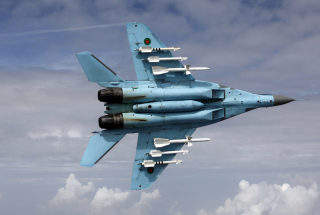Death Match: Russia’s MiG-29 Can Kill F/A-18 Super Hornet Fighters
But neither can do much against China’s J-20.
Here's What You Need to Remember: The airframes and, to a certain extent, engine propulsion may be comparable to decades ago, yet the planes are likely quite different than they were at their inception. The U.S. Navy has been immersed in several F/A-18 Service Life Extension Programs intended to preserve the combat readiness, viability and effectiveness of the jet for many years to come.
The United States, Australia, Japan, and India are all teaming up to prepare for war against China in an upcoming Indo-Pacific joint training exercise intended to strengthen networking and combat effectiveness among the allies.
Several reports explain that U.S. Navy F/A-18 Super Hornets will wargame against Russian-built, Indian MiG-29s in combat preparations, an interesting and potentially challenging combination of what could easily be described as rival aircraft.
Beginning as a Soviet aircraft in the late 70s, the MiG-29K is roughly a chronological equivalent to the U.S. Navy’s F/A-18, however, a margin of difference or similarity in terms of combat performance likely hinges entirely upon the extent to which each 1980s-era plane has been upgraded.
The airframes and, to a certain extent, engine propulsion may be comparable to decades ago, yet the planes are likely quite different than they were at their inception. The U.S. Navy has been immersed in several F/A-18 Service Life Extension Programs intended to preserve the combat readiness, viability and effectiveness of the jet for many years to come. This continues to be made possible by a host of major upgrades to the platform to include the integration of new conformal fuel tanks to increase fuel and extend mission range, the addition of new weapons and avionics, and a new suite of infrared sensor targeting systems.
Thanks to these various updates, the Navy has been able to add thousands of hours to the expected life of the F-18s, while also greatly changing its combat envelope through technology adjustments. The Navy continues to add new avionics, electronics and Infrared Search and Track in-flight targeting sensors to the cockpit, greatly expanding the ability of pilots to find and engage with advanced enemy air threats.
Will this mean it will prove superior to the MIG-29K? Certainly many wanted the answer to that question in the 1980s during the height of the Cold War.
The question now is, in any kind of engagement against China, just how useful would even be upgraded 4th-Generation aircraft be? Could be mixed, it seems.
In one sense neither the MIG-29K or F-18 are likely to operate with an ability to compete against stealthy, 5th-gen Chinese J-20s or J-31s, yet to the extent that major warfare might extend over time, fleet size and advanced 4th-Gen attack systems could easily prove quite valuable, provided the Soviet-era and U.S. F-18s could network with one another and share information.
Should China, or a collection of anti-China allies attain any kind of air superiority in a major war, the country with the more effective 4th-Gen aircraft would it seems be best positioned to prevail. If advanced air defenses are rendered inoperative, then sheer fleet size and strike range expanse could be very decisive.
Kris Osborn is defense editor for the National Interest. Osborn previously served at the Pentagon as a Highly Qualified Expert with the Office of the Assistant Secretary of the Army—Acquisition, Logistics & Technology. Osborn has also worked as an anchor and on-air military specialist at national TV networks. He has appeared as a guest military expert on Fox News, MSNBC, The Military Channel, and The History Channel. He also has a Masters Degree in Comparative Literature from Columbia University. This article first appeared last year.
Image: Wikipedia.


